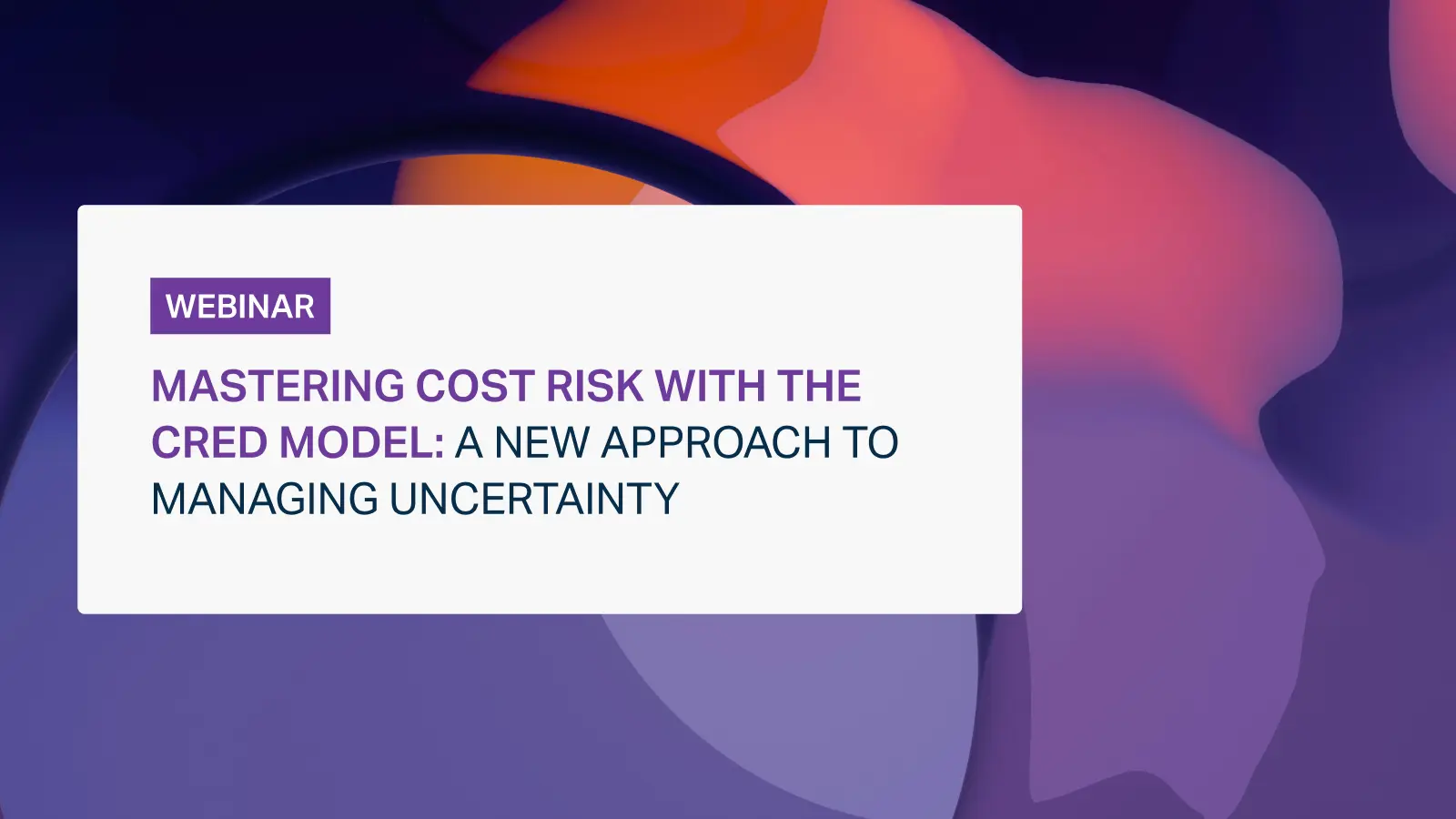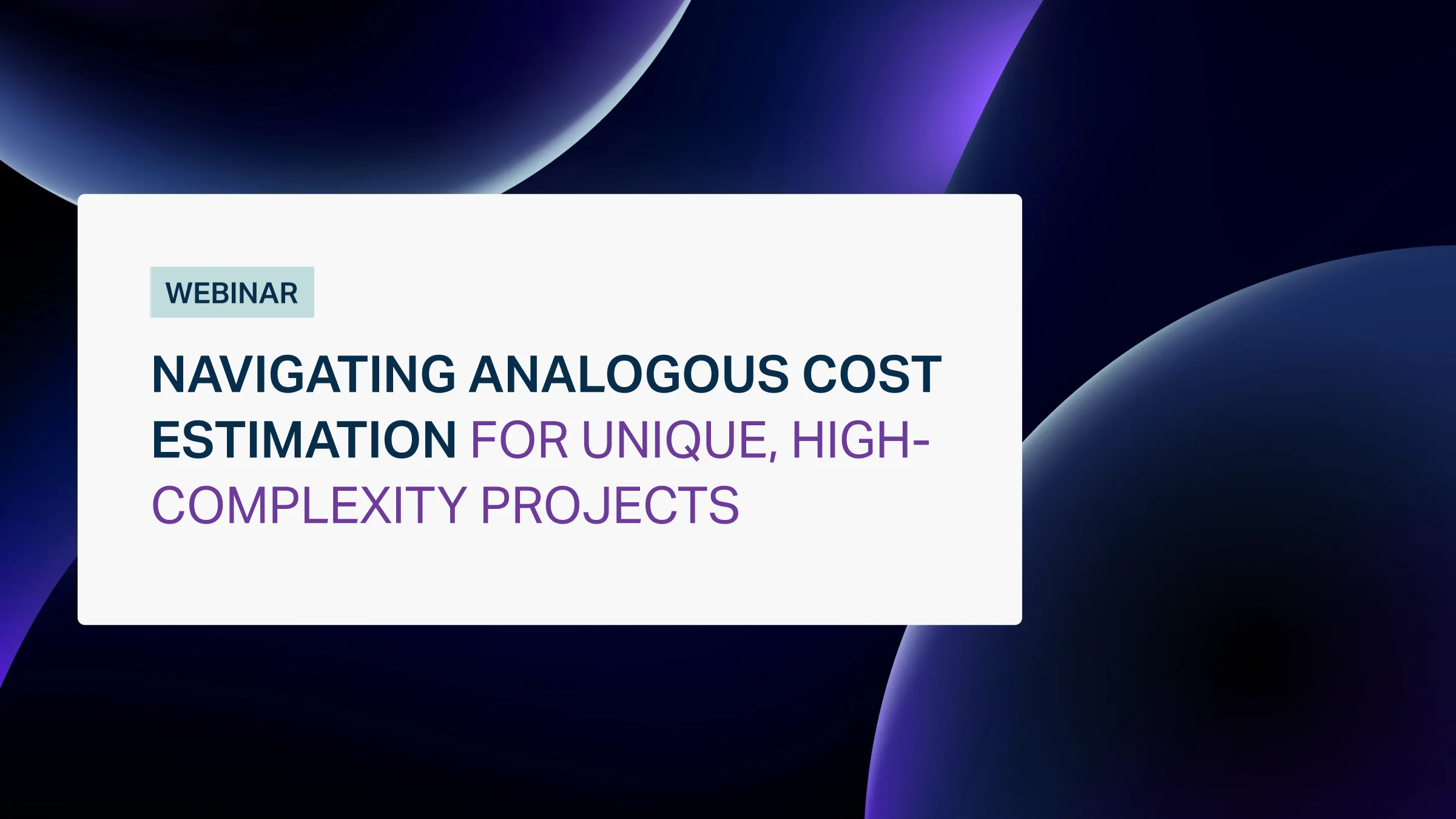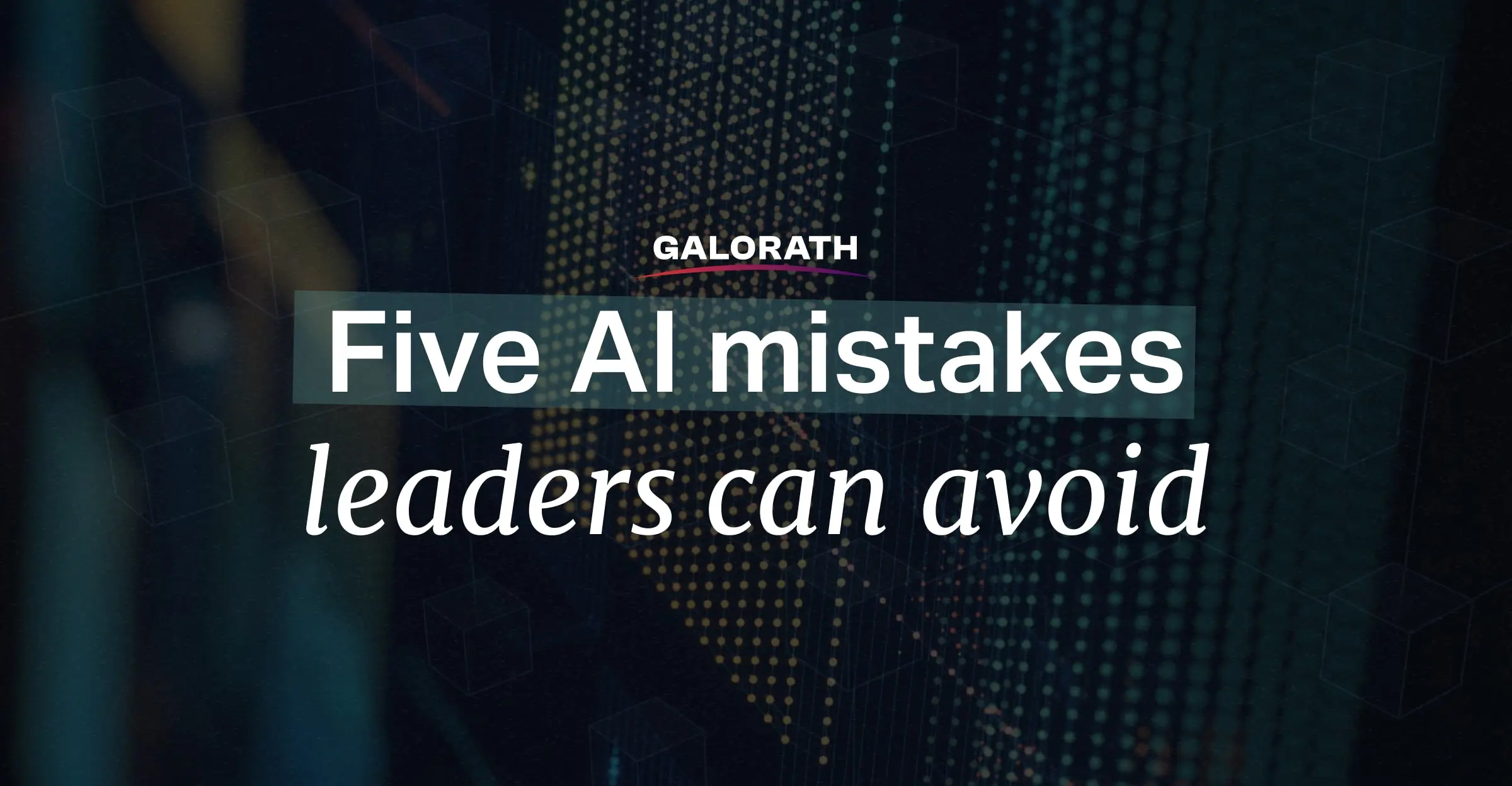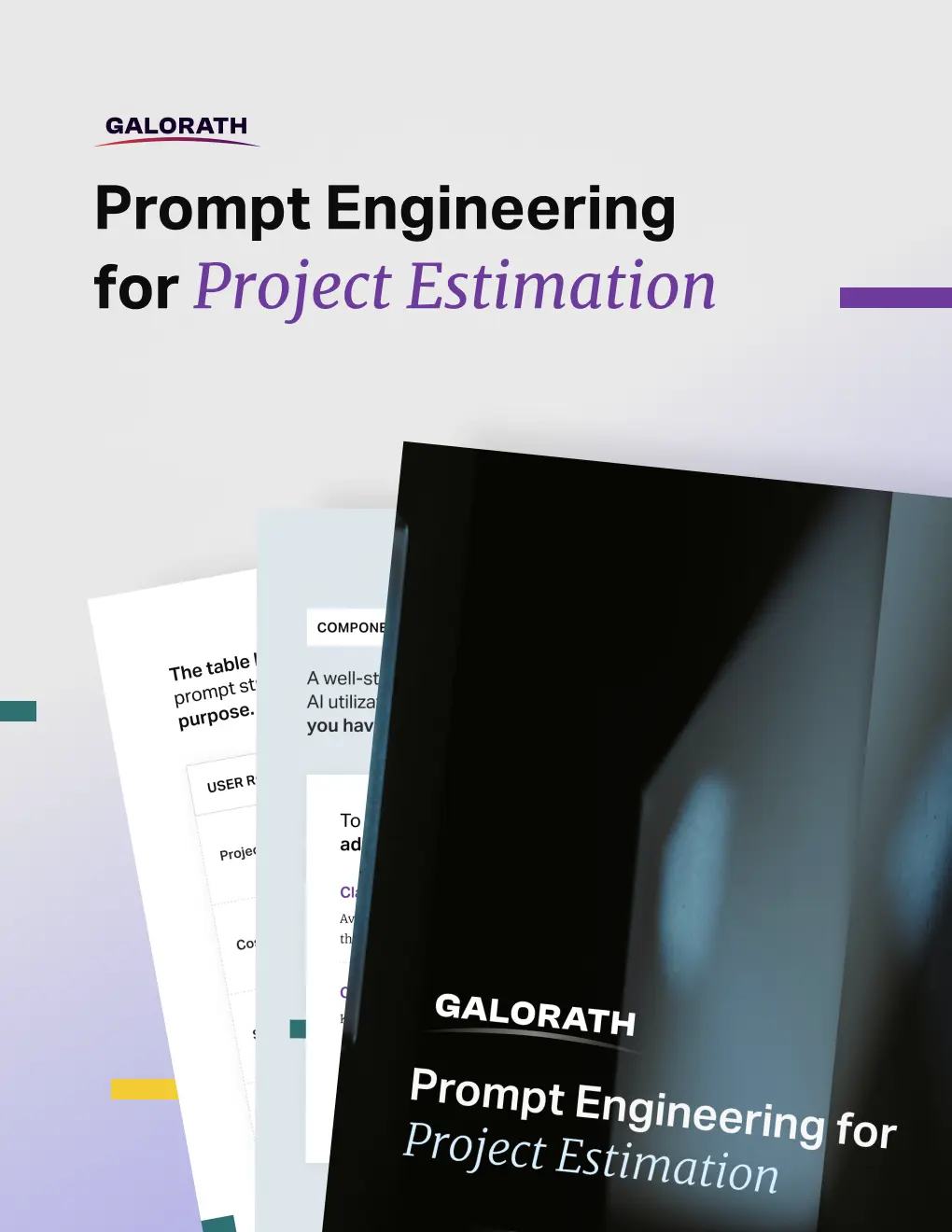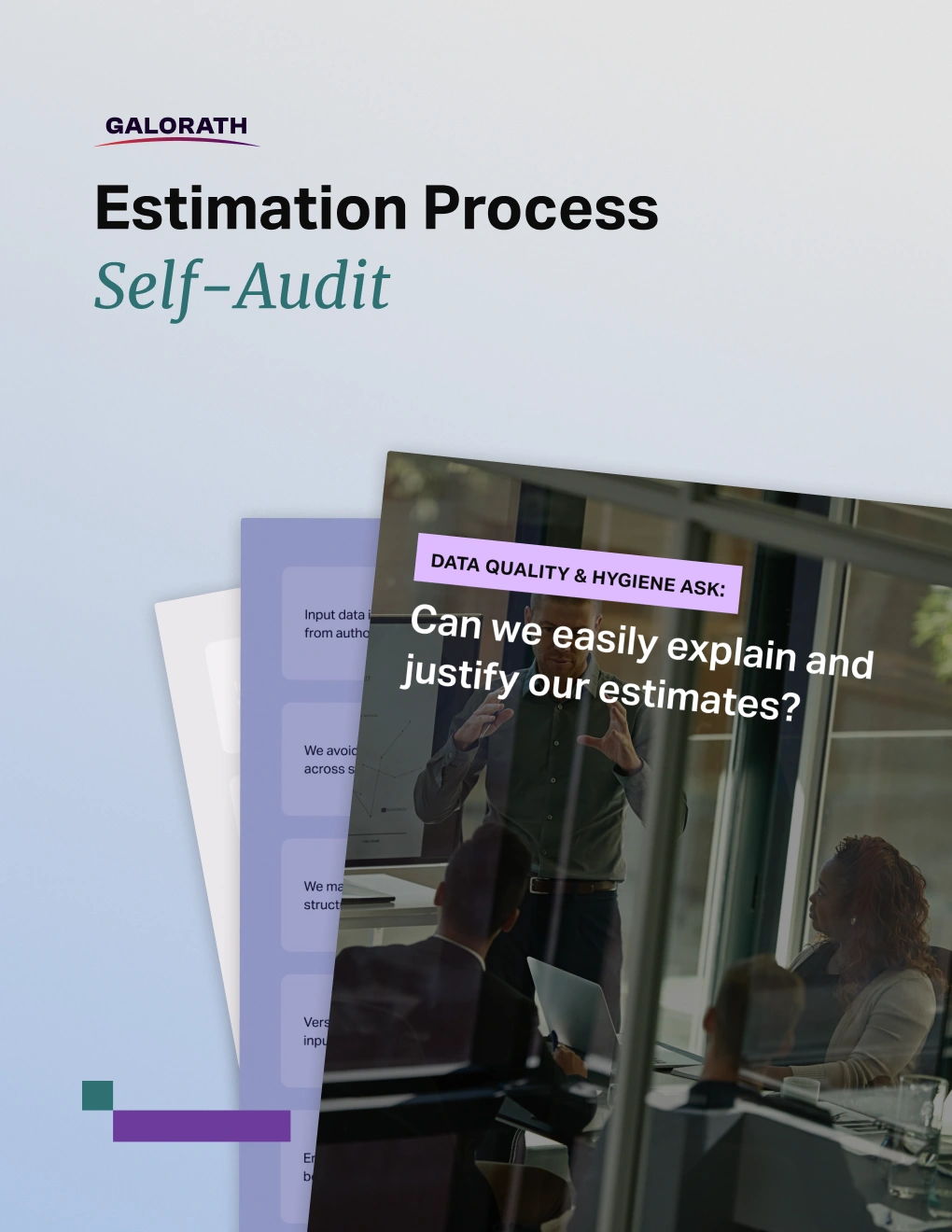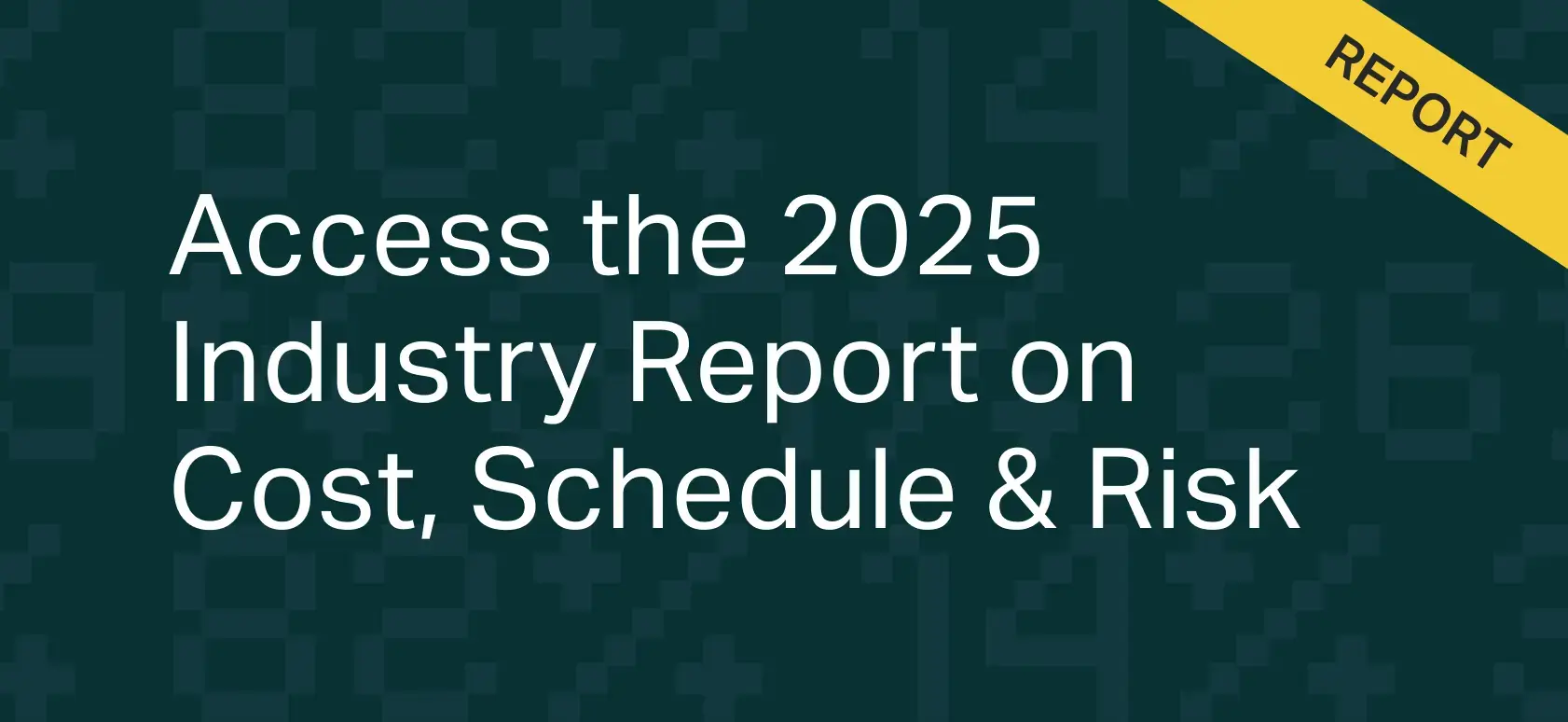Mastering Cost Risk with the CRED Model: A New Approach to Managing Uncertainty
Project governance is a strategic framework that defines how decisions are made, who holds responsibility, and how information flows throughout a project’s lifecycle. Project governance ensures that key stakeholders are aligned on objectives, risk management processes are clearly established, and resources are allocated in a transparent, accountable manner.
This approach reduces confusion over who approves changes or controls budgets, preventing scope creep and keeping the project on track to meet both immediate goals and broader organizational priorities.
Effective project governance leverages well-defined roles, such as steering committees and project sponsors, to maintain visibility and control. It helps monitor milestones, manage stakeholder expectations, and enforce quality standards—ultimately providing a blueprint for consistent execution across multiple phases.
Throughout this article, we’ll explore the definition of project governance, examine its essential components, delve into various governance structures, and review common models in practice. From centralized, top-down frameworks to agile, decentralized approaches, a customized governance system ensures that each project remains strategically aligned, risk-aware, and capable of delivering tangible results.
What Is Governance in Project Management?
Governance in project management is a structured framework that sets out the policies, decision-making pathways, and oversight mechanisms needed to keep projects aligned with an organization’s strategic objectives. It creates accountability, promotes transparency, and ensures compliance, effectively reducing project risks and improving decision-making efficiency.
Project governance is essential for mitigating risks and ensuring alignment with strategic objectives, according to research by Müller (2009). The Project Management Institute (PMI) highlights that organizations with robust governance frameworks experience higher project success rates, better cost control, and more predictable outcomes. A well-defined governance structure enhances project performance, stakeholder confidence, and overall operational efficiency.
Project governance encompasses a range of guiding principles, decision-making processes, stakeholder engagement protocols, and risk mitigation tactics that keep projects on track. This approach standardizes how resources, budgets, and timelines are managed, making certain that project objectives are met while adhering to broader organizational goals, regulatory guidelines, and stakeholder expectations.
The image below outlines Project Governance definition, key benefits, core roles, and common challenges organizations often encounter.
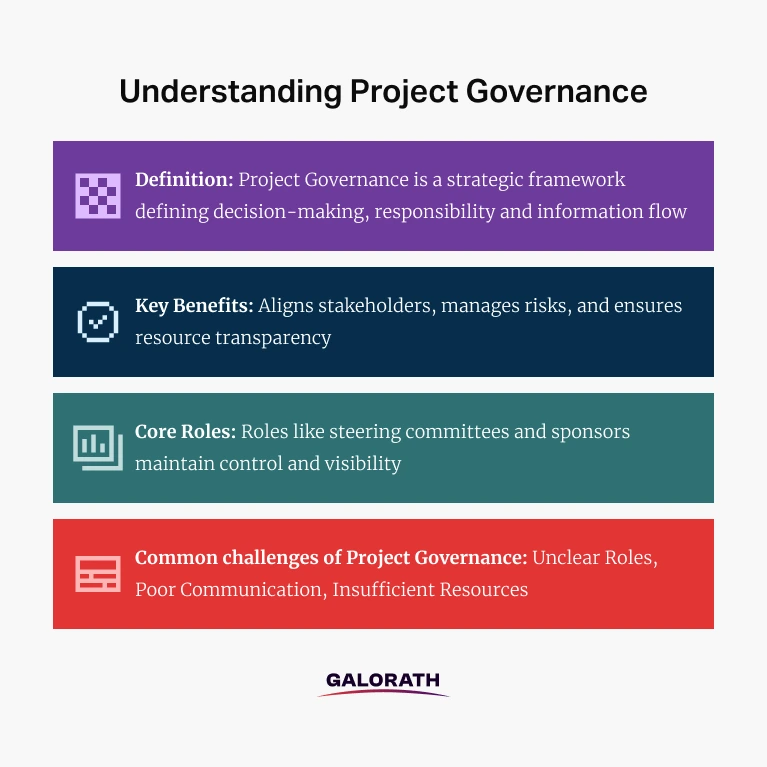
What is the Purpose of Project Governance and Why is it Needed?
The purpose of project governance is to ensure that projects are delivered within scope, on time, and within budget while meeting the strategic goals of the business. This alignment reduces the risk of projects veering off course and provides a clear line of sight from the project’s day-to-day operations to the organization’s long-term vision. Without a formal governance structure in place, projects are more susceptible to mismanagement, scope creep, and conflicting stakeholder interests.
Why is Project Governance needed?
Project governance is needed because it:
- Ensures Strategic Alignment – Governance ensures that projects contribute directly to broader business goals, preventing wasted resources on misaligned initiatives.
- Enhances Decision-Making – Governance establishes clear escalation procedures and decision-making protocols, preventing bottlenecks that delay project progress.
- Minimizes Risk Exposure – A structured governance framework identifies, assesses, and mitigates risks before they become major issues, reducing project failure rates.
- Improves Resource Allocation – Governance defines how financial, technological, and human resources are distributed, optimizing efficiency and preventing misallocation.
- Strengthens Stakeholder Engagement – Establishing clear reporting structures and feedback loops ensures that stakeholders are informed and engaged throughout the project lifecycle.
- Ensures Compliance & Standards – Strong governance ensures projects adhere to legal, regulatory, and industry-specific standards, minimizing legal and reputational risks.
Why Is Project Governance Important?
Project governance is important because it establishes a robust framework for decision-making, accountability, and performance oversight throughout the project lifecycle. By clearly defining who makes decisions and how those decisions are executed, project governance reduces uncertainty, prevents costly misunderstandings, and keeps teams aligned with overarching goals and objectives.
According to a 2023 McKinsey study, organizations with strong governance frameworks can reduce project failure rates by up to 30% while enhancing operational efficiency and cost management.

How Project Governance Reduces Failure Rates?
- Defines Decision-Making Hierarchies- A clear governance model defines authority and decision-making roles, speeding up approvals, resolving issues faster, and reducing conflicts.
- Implements Risk Management Protocols- Governance frameworks include risk management to identify, assess, and mitigate risks. This proactive approach ensures clear contingency plans and accountability, helping prevent small issues from turning into major problems, especially in fast-paced or regulated industries.
- Monitors Performance Continuously – Governance checkpoints and reviews track project health in real-time, ensuring progress aligns with KPIs, stays on schedule, and within budget. Early detection of issues enables quick corrections, reducing the risk of failure.
- Strengthens Accountability – Clearly defined governance roles create transparency in responsibilities, ensuring everyone knows their deliverables, reporting lines, and escalation paths.
- Enhances Budget & Cost Control – Tight governance monitors finances and resource allocation, enforcing regular budget reviews to prevent overspending and ensure efficient fund use, especially in large-scale projects.
Project Governance vs. Project Management
The key difference between project management and project governance lies in their focus on execution versus oversight. Project management handles the day-to-day operations—planning tasks, coordinating resources, managing risks, and ensuring projects are completed on time and within budget. It’s about driving the project forward through tactical actions, whereas project governance provides the strategic framework, defining policies, decision-making authority, and accountability structures. It ensures alignment with organizational goals, sets success standards, and oversees high-level decisions.
What Is the Difference Between PMO and Governance?
A Project Management Office (PMO) is a dedicated team or organizational unit that plays a key role in supporting the execution of projects. It provides resources, methodologies, and best practices that ensure projects are completed effectively. The PMO is responsible for areas like resource allocation, scheduling, and reporting, and it acts as a central hub for knowledge sharing. While the PMO is responsible for day-to-day project support, governance establishes the policies, decision-making structures, and accountability mechanisms.
What Is the Difference Between Project Governance and Assurance?
Assurance is distinct from governance in that it focuses on evaluating whether a project is adhering to the governance framework and meeting the expectations set by it. While governance defines the strategic direction, decision-making structures, and policies, assurance ensures that these rules are being followed effectively. It involves activities such as audits, quality checks, compliance reviews, and performance assessments, conducted independently from the day-to-day project operations to maintain impartiality. Assurance teams assess if the project is on track, if risks are being managed, and if any deviations from the plan are identified and communicated early.
For example, assurance teams might check whether risk assessments are being performed on schedule, validate that metrics reflect actual project performance, and confirm that any changes are managed according to established procedures.
What are the Three pillars of project governance?
Three pillars of Project Governance are structure, people, and information. Structure outlines the frameworks for oversight, people bring expertise and accountability, and information supports transparency and decision-making. Together, they foster alignment, compliance, and successful outcomes throughout the project lifecycle.
- Structure – Structure defines decision-making pathways, escalation procedures, and reporting relationships, ensuring all stakeholders understand their roles and authority levels, from executive sponsors to frontline team members. In addition to assigning responsibilities, structure establishes consistent processes and standards that streamline tasks, prevent confusion, and reduce duplication of effort.
- People – People are central to any governance model, including senior leaders, project managers, and team members. Effective governance requires assigning the right people to the right roles with clear responsibilities. Regular communication, such as status meetings or executive briefs, keeps everyone informed and engaged, enabling the team to adapt to challenges and stay on track in dynamic environments.
- Information – Information gathered through encompassing data via documentation such as risk assessments, budget reports, and performance dashboards are crucial for decision-making in project governance. Timely, accurate information helps leaders identify trends, anticipate issues, and make informed decisions.
The visual below presents the three foundational pillars of project governance.
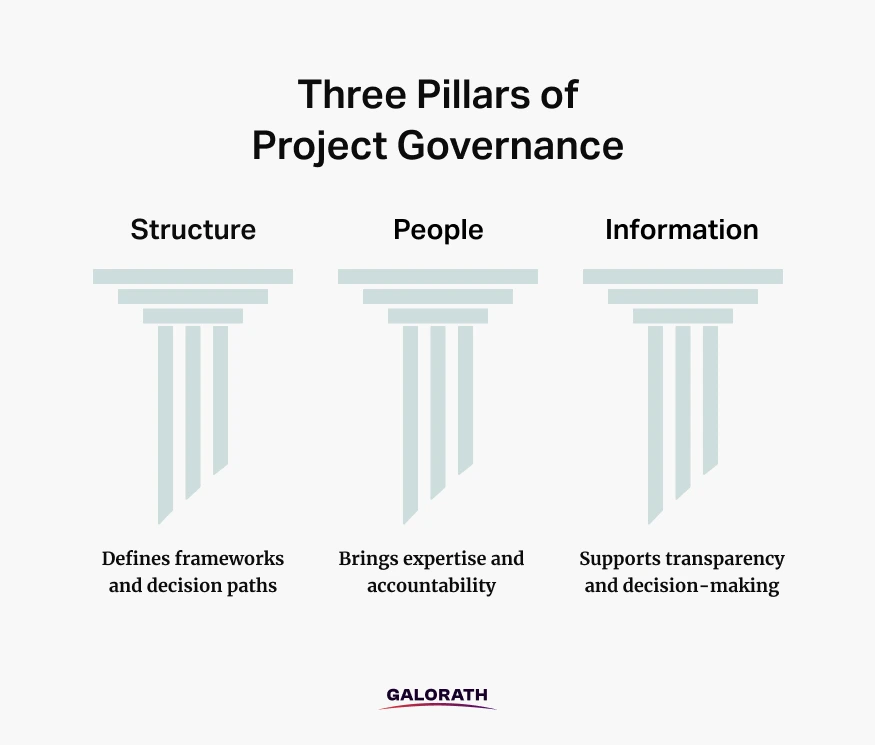
When all three pillars—structure, people, and information—operate in harmony, project governance becomes a powerful mechanism for guiding initiatives to successful outcomes.
What Are the Key Roles in Project Governance?
The key roles in project governance define strategic direction, ensure accountability, and maintain alignment with broader organizational objectives. From executive committees to project managers and advisors, each role contributes essential oversight and decision-making power that drives successful outcomes.
1. Steering Committee
A steering committee is a high-level governance body that provides strategic guidance, oversight, and direction to the project. Members often include senior executives or department leaders who have a vested interest in the project’s success. They review major milestones, approve budget allocations, and resolve escalated issues that cannot be settled at the project team level.
By offering a broader organizational perspective, the steering committee ensures that the project remains aligned with corporate priorities, mitigates risks proactively, and delivers outcomes that support long-term business objectives.
2. Project Manager/Owner
The project manager (or project owner) is responsible for day-to-day coordination, ensuring tasks are completed on time, within budget, and according to defined quality standards. This role involves detailed planning, team leadership, and continuous monitoring of progress against the project plan.
The project manager communicates updates to stakeholders, manages risks, and navigates challenges that arise. By maintaining a focus on operational efficiency and effective resource allocation, the project manager bridges the gap between strategic goals set by governance bodies and the practical realities of delivering tangible results.
3. Stakeholders
Stakeholders include individuals, groups, or organizations directly or indirectly affected by the project’s outcomes. They can be internal teams such as finance or operations, external partners like vendors or regulatory agencies, or even end-users who will interact with the final product or service.
Engaging stakeholders early and consistently is crucial to gathering diverse perspectives, managing expectations, and securing buy-in. Feedback loops, workshops, and regular status updates help stakeholders stay informed and involved, ensuring that the project’s goals remain relevant and that any concerns are addressed promptly.
4. Project Sponsor
A project sponsor is typically a senior executive who champions the project at the highest organizational level. This individual secures the necessary funding and resources, provides strategic oversight, and serves as the primary advocate for the initiative’s goals.
The project sponsor also acts as a key decision-maker on critical issues, stepping in when conflicts require executive support or when additional authority is needed to keep the project on track. By maintaining a close relationship with the project manager and steering committee, the sponsor drives alignment with broader business objectives.
5. Team Members
Team members are the engine of project execution, bringing the specialized skills, expertise, and hands-on effort needed to fulfill deliverables. They collaborate under the guidance of the project manager, handle assigned tasks, and share responsibility for quality, timelines, and budget adherence.
This group may include technical experts, designers, marketers, or any role crucial to the project’s success. In effective governance frameworks, team members receive clear instructions, maintain open communication channels, and leverage collaboration tools to stay coordinated, adapt to change, and consistently meet performance benchmarks.
6. Advisors & Consultants
Advisors and consultants provide specialized knowledge, helping to navigate complex technical requirements, regulatory challenges, or strategic roadblocks. They can be external subject matter experts or internal specialists brought in from other departments. Their role often involves conducting in-depth research, offering training, or benchmarking against industry standards.
By offering an outside perspective, advisors help identify best practices and innovative solutions. Through regular consultation sessions or dedicated reviews, they guide decision-making, mitigate risks, and ensure that the project remains efficient, compliant, and equipped to achieve its intended outcomes.
7. Project Management Office (PMO)
A Project Management Office (PMO) supports governance by standardizing processes, providing resources, and promoting best practices across multiple initiatives. It typically develops and maintains project documentation templates, defines methodologies, and offers training to project teams.
The PMO can also play a role in tracking performance metrics, consolidating reports for executive review, and ensuring that projects align with strategic business goals. Through consistent oversight and process improvement, the PMO enhances transparency, reduces duplication of effort, and fosters a culture of continuous learning within the organization.
8. Change Control Board
A Change Control Board (CCB) is responsible for evaluating and approving any significant changes to the project’s scope, schedule, or budget. Members may include representatives from the steering committee, the PMO, and key functional areas affected by potential modifications.
The board weighs the impact, benefits, and risks of each proposed change before rendering a decision. By maintaining rigorous standards for documentation and review, the CCB prevents scope creep and ensures that any alterations support the project’s strategic objectives, safeguarding both resources and long-term stakeholder satisfaction.
The image below outlines eight key roles within project governance, each contributing to accountability, oversight, and successful project delivery.
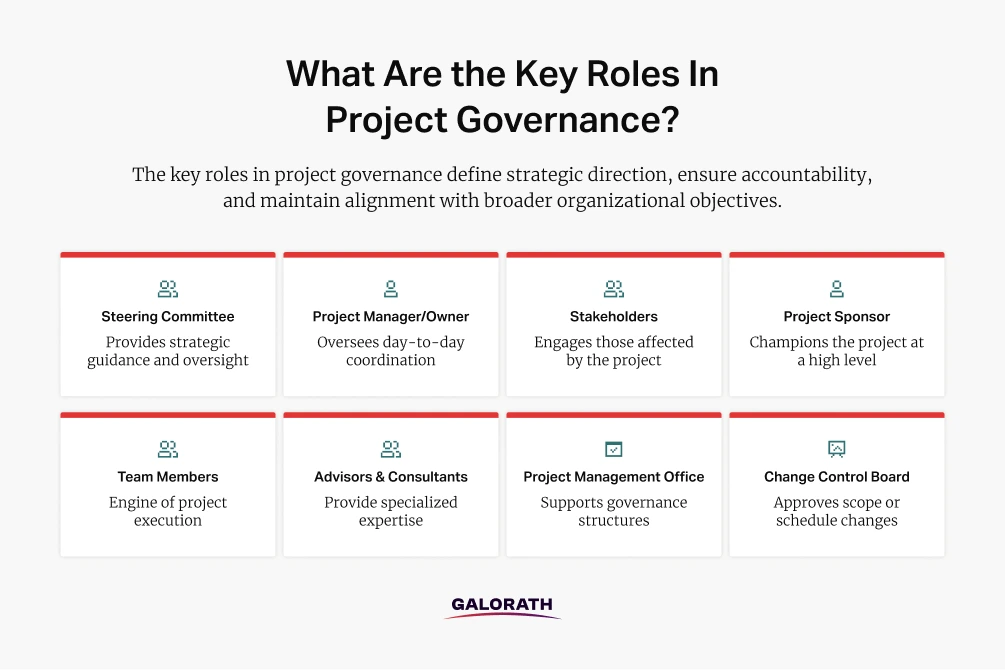
When Should Governance Roles Be Defined?
Establishing governance roles as early as possible—ideally at the project’s initiation phase—sets the stage for structured decision-making and transparent accountability. This ensures that all stakeholders understand who holds authority, who is responsible for which tasks, and how critical project decisions will be made.
As projects evolve, governance roles should be reviewed at major milestones, such as deliverable completions or scope changes. Adjustments may be necessary to address new challenges or regulatory requirements.
10 Key Components of Project Governance
There are specific 10 key components of project governance that ensure that projects align with organizational objectives, follow established processes, and achieve intended outcomes.
Below are the 10 elements that contribute to strong governance practices:
- Defined Governance Structure
A clear framework outlines how decisions are made and who holds authority. This structure specifies the roles of executive sponsors, steering committees, and project managers, providing an organized approach to overseeing project activities.
- Roles and Responsibilities
Clearly assigning responsibilities prevents confusion and streamlines decision-making. By defining who does what—from risk assessments to progress reporting—teams work more cohesively, and accountability becomes easier to track.
- Decision-Making Processes
Transparent, well-documented pathways for making both strategic and tactical decisions help maintain momentum. Approvals, escalations, and conflict resolutions are handled efficiently, enabling faster adaptation to changes or challenges.
- Risk Management
A proactive approach to identifying, assessing, and mitigating risks is central to project governance. By implementing formal risk registers, monitoring potential threats, and assigning ownership for risk response plans, teams are better prepared to address uncertainties before they escalate.
- Stakeholder Engagement
Engaging the right stakeholders at the right time ensures that decisions are well-informed and that diverse perspectives are considered. Regular check-ins, feedback loops, and inclusive communication foster trust and bolster collaboration.
- Communication Channels and Reporting
Consistent, clear communication helps stakeholders stay informed about progress, challenges, and successes. Whether through status reports, dashboards, or live updates, timely information sharing reinforces transparency and fosters informed decision-making.
- Performance Monitoring and Control
Tracking project performance against predefined metrics and milestones highlights deviations early. Governance bodies can then make data-driven adjustments to keep schedules, budgets, and deliverables on course.
- Change Management
Projects often evolve, so having a structured change management process is essential. A formal method for evaluating, approving, or rejecting changes ensures that scope, cost, and timeline adjustments are managed in a controlled manner.
- Resource Management
Ensuring that the right people, tools, and budget are available at the right time helps maintain project momentum. This includes setting clear resource allocation rules and monitoring utilization to avoid bottlenecks or constraints.
- Continuous Improvement and Learning
Lessons learned from each phase feed into future projects, enhancing governance practices over time. By capturing best practices and avoiding repeated mistakes, organizations evolve their approach and maintain competitive advantages in project delivery.
When these components work together, project governance becomes a guiding force that aligns objectives, minimizes risk, and promotes transparency. This integrated approach lays the groundwork for successful project outcomes and sustained organizational growth.
What Does Good Project Governance Look Like?
Good project governance features a well-structured framework, effective decision-making mechanisms, and continuous alignment with organizational objectives. It provides a roadmap for how projects should be managed, including the roles and responsibilities of key participants, the reporting mechanisms for progress updates, and the procedures for managing risks or changes.
Well-planned governance frameworks establish milestones and performance metrics to track progress, ensuring that teams remain focused on delivering outcomes that meet stakeholder expectations. These frameworks also emphasize regular communication and feedback loops, which promote adaptability and maintain alignment with strategic goals.
What Are 4 Core Project Governance Principles?
At the heart of effective project governance are four foundational principles—single point of accountability, independent project ownership, separation of stakeholder management and decision-making, and distinct project and organizational governance structures.
These principles create a focused environment where teams can confidently deliver outcomes that fulfill both project and organizational goals.
- Single Point of Accountability
Effective governance begins with assigning clear ownership for the project’s success. A single point of accountability—often a sponsor or high-level executive—ensures decisive leadership, reduces ambiguity, and provides a definitive authority for critical decisions.
- Independent Project Ownership
Separating the project from asset, service, or other stakeholder group ownership keeps decision-making focused on project goals rather than competing interests. By maintaining this independence, the governance framework can prioritize project outcomes, address risks more objectively, and preserve the integrity of the project’s scope.
- Separation of Stakeholder Management and Decision-Making
Stakeholders should be engaged for feedback, insights, and support, but decision-making must remain distinct to prevent undue influence or bias.
- Distinct Project and Organizational Governance
Maintaining separate structures for project governance and organizational governance avoids overlapping authority and conflicting directives. The project governance framework deals specifically with project objectives, while organizational governance handles broader company priorities and strategies.
The following visual highlights four core principles of project governance.

What is a Project Governance Model?
A project governance model is a structured blueprint that defines how a project is directed, controlled, and monitored to achieve its objectives. The model’s main purpose is to maintain alignment with organizational strategy, uphold accountability, and foster transparent communication among stakeholders. By outlining clear escalation paths and reporting requirements, a governance model offers teams an organized approach to handling risks, budgets, and timelines.
Well-defined governance models can significantly improve project performance and reduce failure rates, according to a 2021 survey by the Project Management Institute (PMI). Ultimately, the project governance model acts as a guiding compass, keeping initiatives aligned with broader business goals while enabling informed, evidence-based decision-making at every stage.
What Are the 5 Project Governance Models?
Below are the 5 common project governance models:
1. Collaborative Governance Model
A collaborative governance model emphasizes teamwork, open dialogue, and shared accountability, bringing together diverse stakeholders to collectively shape project strategies and outcomes. Rather than relying on a single decision-maker or small group of executives, this approach encourages ongoing collaboration among cross-functional teams, sponsors, end-users, and other interested parties.
This inclusive method can lead to stronger buy-in, as stakeholders feel directly involved in shaping the project’s direction and success criteria. Such collective input often results in more balanced solutions that accommodate different perspectives.
However, collaborative governance also requires disciplined meeting structures, effective facilitation, and a clear escalation process to prevent delays and inefficiencies when reaching consensus on critical project decisions.
2. Agile Governance Model
An agile governance model focuses on flexibility, continuous learning, and rapid adaptation to evolving project needs. Instead of rigid hierarchies, it relies on iterative feedback loops, short development cycles (sprints), and empowered teams that can make on-the-spot decisions.
Governance under agile frameworks often involves frequent stand-ups, sprint reviews, and retrospectives, during which stakeholders and team members assess progress, share feedback, and plan immediate next steps. This transparent, iterative process ensures that issues and risks are discovered early, reducing the likelihood of large-scale failures late in the project’s timeline.
The model encourages cross-functional collaboration and alignment with changing user requirements or market conditions. Agile governance also fosters a culture of collective ownership and accountability, as all participants—from developers to product owners—share responsibility for delivering value.
Nevertheless, it demands disciplined tracking and clear communication protocols to maintain strategic alignment, prevent scope creep, and ensure project goals remain visible to key decision-makers.
3. Functional Governance Model
The functional governance model groups project activities and decision-making authority according to specialized departments or functional areas, such as finance, marketing, or operations. In this setup, each department has clearly defined responsibilities, ownership over specific processes, and a say in how relevant parts of the project should be executed.
This structure allows teams to capitalize on deep expertise within each function, ensuring that subject matter experts guide decisions in areas like budget forecasting, compliance, or technical design.
Although this model can enhance quality by leveraging specialized knowledge, it also requires careful integration and collaboration among functional leads. Project managers often act as the bridge between departments, ensuring that each function’s contributions align with the overall roadmap.
4. Hierarchical Governance Model
A hierarchical governance model places authority and decision-making power in a top-down structure, often led by senior executives, steering committees, or a project sponsor. Direction and policies flow from these upper levels to project managers and then on to individual teams.
This model excels in organizations that need clearly defined chains of command or operate in heavily regulated environments where consistency and compliance are critical.
Responsibilities are typically segmented by role or rank: senior leaders set strategic objectives, while mid-level managers oversee the daily execution of tasks. This approach simplifies accountability, as each role has specific oversight responsibilities.
However, responsiveness can be slowed when multiple approval layers are required for even minor changes. Careful communication planning is vital to keep everyone aligned and informed, preventing bottlenecks that may develop as information and decisions flow through hierarchical tiers.
5. Decentralized Governance Model
A decentralized governance model disperses decision-making authority across various teams or departments, granting them autonomy over how they plan, execute, and monitor their specific components of the project. Rather than relying on a central command structure, this approach places trust in local expertise and specialized knowledge, allowing each group to tailor its processes to particular needs.
Decentralization can accelerate innovation and responsiveness because decisions are made closer to the actual work. Cross-functional teams, for instance, can resolve issues quickly without waiting for top-level approvals.
At the same time, overall alignment is maintained through shared goals, periodic reviews, and reporting standards that keep leadership in the loop. However, it also demands clear communication channels, strong collaboration skills, and robust coordination mechanisms to prevent silos, contradictory strategies, or misaligned resource allocation across different parts of the project.
The image below presents five common project governance models, illustrating different structures organizations use to manage oversight, accountability, and strategic alignment.
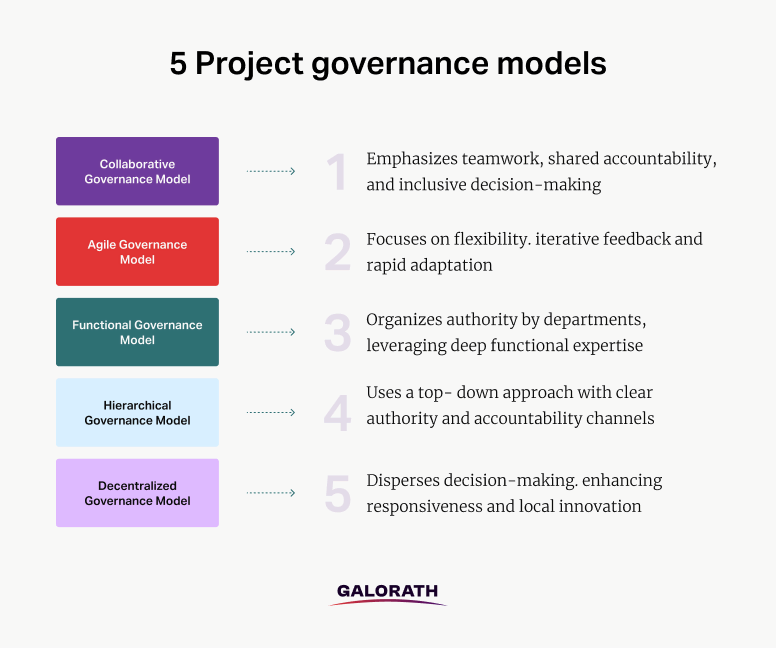
6 Benefits of Project Governance
Project governance has many benefits. Below is a list of 6 benefits of a effective project governance:
- Clear Accountability
Good governance frameworks define who is responsible for major decisions, task completion, and final deliverables. This clarity reduces confusion, prevents overlapping duties, and helps teams stay on track. By establishing specific ownership across all project stages, issues and questions can be escalated to the right people, ensuring swift resolution. Ultimately, clear accountability underpins transparency, keeps everyone focused on shared goals, and fosters a more cohesive project environment.
- Proactive Risk Management
Effective project governance includes mechanisms to identify, assess, and mitigate risks before they become critical issues. By continuously monitoring potential pitfalls—such as budget constraints, resource limitations, or shifting stakeholder requirements—teams can adapt strategies and allocate resources more efficiently. This proactive approach not only preserves project momentum but also boosts stakeholder confidence, showing that the project is well-prepared to handle uncertainty.
- Efficient Use of Resources
Strong governance structures help prioritize tasks, ensuring that time, budget, and human capital are directed toward the most critical activities. Clearly defined processes and approval pathways reduce duplication of efforts, preventing delays and cost overruns. When everyone understands where their work fits into the larger picture, resources are deployed with greater precision, leading to streamlined operations and optimized project outcomes.
- Alignment with Business Objectives
A robust governance framework maintains a close link between day-to-day project activities and the broader strategic goals of the organization. By setting measurable performance metrics and reviewing progress regularly, decision-makers can confirm that each milestone contributes to overarching objectives. This alignment ensures that projects not only stay relevant but also deliver meaningful value to the business, rather than being siloed efforts disconnected from core priorities.
- Enhanced Stakeholder Engagement
Structured governance models create regular communication channels and feedback loops. This keeps stakeholders informed about key developments, fosters trust, and encourages buy-in from diverse groups—such as end-users, senior leadership, and external partners. When stakeholders have a voice in project decisions and can see consistent progress updates, they are more likely to offer support, resources, and actionable insights that drive the project’s success.
- Continuous Improvement and Learning
Governance frameworks typically include post-project reviews, lessons-learned sessions, and performance evaluations. These practices capture insights about what worked well and where improvements are needed. Documenting and sharing these findings strengthen the organization’s overall project management capabilities, enabling teams to refine processes, avoid repeating mistakes, and achieve higher levels of efficiency and quality in future endeavors.
The visual below outlines six key benefits of implementing effective project governance.
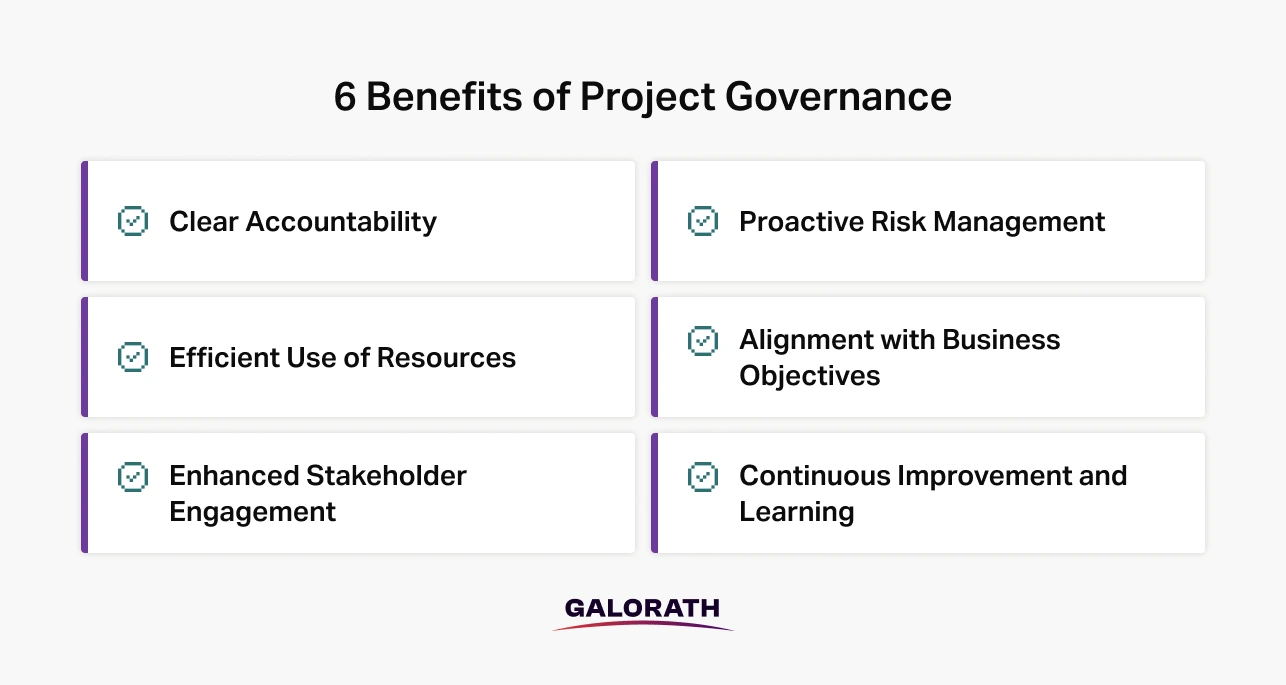
How Do You Ensure Effective Project Governance?
Effective project governance is ensured by establishing clear accountability, transparent decision-making processes, and regular stakeholder engagement. Assigning ownership for critical decisions, documenting approval structures, and fostering open communication minimizes misunderstandings and streamlines execution.
Proactively identifying and managing risks prevents disruptions, while aligning project milestones with organizational goals ensures long-term value. Continuous improvement through feedback loops and performance evaluations enhances governance processes over time, creating a structured yet flexible framework that drives project success.
What Are the Most Common Challenges of Project Governance?
The most common challenges of project governance revolve around unclear roles, stakeholder disengagement, poor communication, insufficient resources, uncontrolled scope changes, and misalignment with strategic objectives. Below are some of the most frequent issues organizations encounter:
- Unclear Roles and Responsibilities
When governance structures are vague, team members may not know who has final decision-making authority or how to escalate problems. This lack of clarity slows progress and can lead to duplicated work or overlooked tasks.
- Lack of Stakeholder Buy-In
If stakeholders do not feel included or informed, they may withhold support or resist new initiatives. Poor engagement diminishes the project’s credibility and undermines effective governance.
- Poor Communication Channels
Limited or inconsistent reporting disrupts the flow of information, hindering timely updates and collaborative decision-making. Without transparent communication, risks and bottlenecks can go unnoticed until they become critical.
- Insufficient Resource Allocation
Even a solid governance framework cannot succeed if budget, manpower, or tools are consistently lacking. This shortfall raises the likelihood of missed deadlines, quality issues, and general team frustration.
- Scope Creep and Change Management Gaps
Projects without robust procedures for approving or rejecting changes may face expanding deliverables, ballooning costs, and shifting timelines. A clear governance structure is essential to evaluate and control scope adjustments.
- Misalignment with Organizational Goals
Governance that fails to regularly align a project with the larger strategy can lead to wasted resources and confusion. Continual checkpoints and reviews help ensure the project remains relevant to overall business objectives.
Project Governance Examples
Project governance examples can be found in a wide range of industries, highlighting how different sectors apply structured oversight, decision-making processes, and accountability measures to ensure successful project outcomes.
Below are several scenarios where project governance plays a pivotal role:
- Software Implementation for Enterprise Resource Planning (ERP)
When rolling out a new ERP system, governance teams define change management policies, assign clear roles for data migration, and establish checkpoints to monitor implementation progress. This structure helps ensure that cost, scope, and timelines remain under control, while user training and adoption receive the necessary attention.
- Healthcare System Upgrades
In hospital settings, governance frameworks help balance clinical needs with regulatory compliance and patient safety mandates. Committees composed of healthcare leaders, IT specialists, and finance managers review project milestones, allocate resources, and track issues that could affect patient care. This integrated oversight ensures that patient outcomes remain the top priority.
- Government and Public Sector Initiatives
Public agencies often deploy governance structures to manage large-scale, taxpayer-funded projects like infrastructure improvements or digital services. Dedicated steering committees and transparent reporting channels promote accountability and enable elected officials, citizens, and regulatory bodies to track spending, progress, and benefits realization.
- Product Launch and Market Expansion
For consumer-facing businesses entering a new market, governance provides a consistent framework to evaluate market research, approve marketing budgets, and manage cross-functional teams. Steering committees consisting of executives, product owners, and legal advisors ensure that brand positioning and compliance regulations are correctly followed, reducing the risk of costly missteps.
Is the RACI Model Relevant to Project Governance?
Yes, the RACI model (Responsible, Accountable, Consulted, Informed) is a vital tool in project governance. It provides clarity in defining roles and responsibilities, ensuring accountability and reducing confusion in decision-making processes.
How the RACI Model Enhances Project Governance:
- Prevents Role Ambiguity – Clearly distinguishes who is responsible, accountable, consulted, and informed, preventing duplication of effort and inefficiencies.
- Improves Communication Flow – Ensures that the right stakeholders receive updates and approvals at appropriate project stages.
- Enhances Decision-Making – Assigns responsibility and accountability, making governance decisions more efficient.
- Supports Compliance & Risk Management – Provides a structured framework for decision-making that aligns with regulatory and compliance requirements.
- Increases Project Efficiency – Ensures the right individuals are engaged at the right time, reducing delays and bottlenecks.
Many organizations integrate the RACI model into their governance frameworks to ensure effective collaboration, transparency, and accountability at every stage of the project lifecycle.
How to Set Up a Custom Project Governance Structure
Setting up a custom project governance structure can be done in 7 simple steps. Below is an approach to creating a tailored governance framework.
- Clarify the Project’s Objectives
Start by outlining the project’s purpose, intended outcomes, and success criteria. This foundation sets a clear direction for all governance decisions and helps stakeholders understand what must be achieved. - Identify Key Stakeholders and Sponsors
Determine who will champion the project at the executive level, and involve individuals whose input or approval will significantly impact its success. This ensures sufficient support, clear escalation paths, and reliable resource allocation. - Define Roles and Responsibilities
Clearly describe governance roles—such as a steering committee, project sponsor, or advisory board—and articulate each group’s authority level. This eliminates confusion and prevents overlap in decision-making. - Establish Governance Committees
Form dedicated committees or working groups to manage critical areas like risk, scope, or quality. By assigning specific domains to these committees, you enable focused oversight and streamlined reporting. - Document Key Processes and Procedures
Outline how decisions are made, issues are escalated, and changes are approved. By codifying these processes in a reference guide, team members know where to look for guidance and how to handle unanticipated challenges. - Create Reporting and Communication Channels
Define when and how updates are shared across the organization. Use status reports, dashboards, or regular briefings to maintain transparency and foster collaboration among all stakeholders. - Implement Review and Feedback Cycles
Schedule regular checkpoints to assess project progress and the effectiveness of the governance structure. Invite constructive input from all levels, making adjustments as necessary to improve processes, accountability, and stakeholder satisfaction.
How is Project Governance Connected with Project Planning?
Project governance plays a crucial role in project planning by establishing the foundation for decision-making, accountability, and risk management before execution begins.
By embedding governance principles into the project planning phase, organizations can significantly reduce risks, improve project efficiency, and increase the likelihood of success.
Effective project governance is also the foundation of successful project execution. By implementing a structured governance framework, organizations can ensure accountability, risk mitigation, compliance, and strategic alignment. Whether through collaborative, agile, hierarchical, or decentralized models, strong governance leads to higher success rates, better resource utilization, and more predictable project outcomes.
